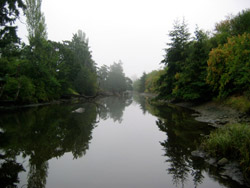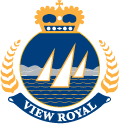Environmental Regulations
 View Royal is actively working to maintain a liveable, green and sustainable community by ensuring the ongoing health and protection of its diverse natural environment. View Royal's Official Community establishes a number of goals and policies with respect to the protection of the natural environment. View Royal also seeks to protect its natural environment through a number of bylaws including:
View Royal is actively working to maintain a liveable, green and sustainable community by ensuring the ongoing health and protection of its diverse natural environment. View Royal's Official Community establishes a number of goals and policies with respect to the protection of the natural environment. View Royal also seeks to protect its natural environment through a number of bylaws including:
- Protection of trees through the Tree Protection Bylaw.
- A 15m required setback for buildings and structures from the natural boundary of freshwater streams and the shoreline of Esquimalt Harbour, Portage Inlet and the estuaries of Millstream and Craigflower creek (see section 36(2) of the Land Use Bylaw and Council policy.
- A requirement for Environmental Development Permits for new development in riparian areas or sensitive environmental areas as specified by section 5.2 of the Official Community Plan. The management of rainwater (stormwater) runoff to minimize the pollutants and manage the quantity of water reaching the Town's streams, estuaries and the ocean through the Land Use Bylaw. A prohibition against backyard burning.
- A prohibition against the discharge of waste into storm sewers and watercourses.
- Soil deposit and removal permitting process.
Other levels of government also have a number of programs and environmental regulations which apply in View Royal and these include:
Regional Solid Waste Management Plan
(Capital Regional District)
The CRD Solid Waste Management Plan provides regulations for the management of solid waste disposal, recycling and household hazardous waste within the Capital Regional District.
CRD Idling Control Bylaw
(Captial Regional District)
The CRD Idling Control Bylaw is a region-wide bylaw which restricts vehicle idling to three (3) minutes. This bylaw was enacted as a measure to address health concerns in the region due to visible sources of pollution.
Regional Source Control Program
(Capital Regional District)
The CRD Source Control Program is a pollution prevention initiative aimed at reducing the amount of contaminants that industry, businesses, institutions and households discharge into the district's sanitary sewer systems.
Riparian Area Regulation
(Ministry of Environment)
Riparian areas are the areas bordering on streams, lakes, and wetlands that link water to land and directly influences and provides fish habitat. Protecting this riparian fish habitat, while facilitating urban development that exhibits high standards of environmental stewardship, is a priority for the Government of British Columbia.
The purpose of the Regulation is to protect the features, functions and conditions that are vital in the natural maintenance of stream health and productivity.
Environmental Management Act
(Ministry of Environment)
The Environmental Management Act protects human health and the quality of water, land and air in British Columbia with regard to discharges impacting those sites. The act, along with the Contaminated Sites Regulation, provides standards for site quality and regulates site investigation and remediation requirements. Sites requiring remediation include brownfields and other low to high risk contaminated sites.
Fisheries Act
(Department of Fisheries and Oceans Canada)
Canada's Fisheries Act provides for the protection of fish and fish habitat. No one may carry out work in or near Canadian waters that prevents fish passage, results in fish mortality or results in the harmful alteration, disruption or destruction of fish habitat without authorization from Fisheries and Oceans Canada.
Development proposals that involve a work or undertaking in or near water may be required to submit their proposal to the Department of Fisheries and Oceans Canada for review. Fisheries and Oceans Canada evaluates the potential impacts of a proposed development to fish and their habitat to ensure compliance with the Fisheries Act. The Department may propose additional measures or alternative designs to avoid or reduce potential impacts to fish and the fish habitat.
Esquimalt Harbour Licence of Occupation
(Department of National Defence)
The installation, construction or alteration of works below the high water line in Esquimalt Harbour is regulated by three agencies:
- CFB Esquimalt Port Operations and Emergency Services Branch
- Fisheries and Oceans Canada/Habitat Management Program
- Transport Canada/Navigable Waters Protection Program
A property owner contemplating the installation, construction, demolition or modification of a structure that extends into Esquimalt Harbour below the high water mark will require approval from all three agencies.
Water Act
(Ministry of Environment)
Any modification to the nature of a stream including the land, vegetation, natural environment or flow of water within the stream, or an activity or construction within the stream channel, requires a written authorization from the Ministry of Environment, in accordance with section 9 of the Water Act.

